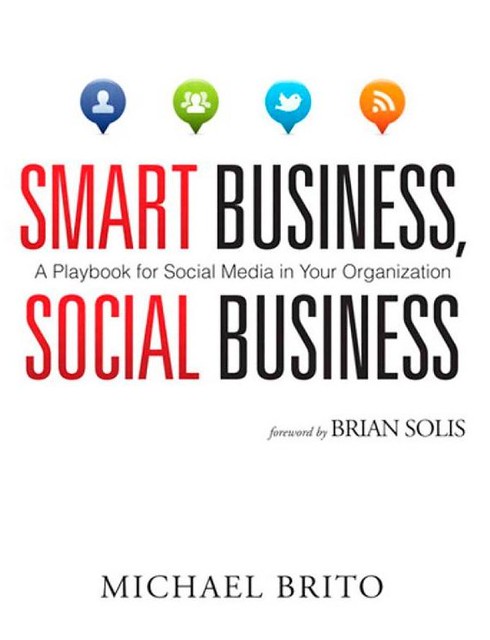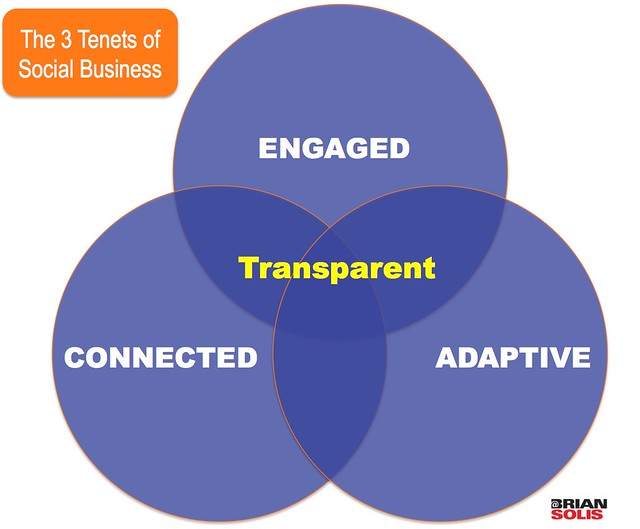
I got to know Michael Brito several years ago when he worked on the social media team at Intel. Since then, we’ve worked together in a variety of projects becoming good friends along the way. I was proud when Michael landed his book deal for Smart Business, Social Business and I was honored when Michael asked me to write the Foreword.
Smart Business, Social Business is now available and the publisher has agreed to let me share the foreword here. Enjoy!
Adapting Businesses to Meet the Needs of the Connected Customer
The social media movement is far more important than we realize. Several years ago I compared the democratization of information to the economic impact realized during the Industrial Revolution. Indeed, social media is much more than Twitter, Facebook, and YouTube. Social media is a lens into the future of business and the relationships that are created between brands and customers. However, social media can only benefit the organization if its promise is unlocked across the entire organization and not siloed in any one department or function.
Hosting a dynamic Facebook presence and active Twitter stream does not make a business social. Pointing to these accounts in marketing and advertising material also do not make a business social. So what, then, defines a social business?
A social business is one with its communities, wherever they reside. As customers view businesses as one brand and not as a series of disconnected units or departments, a social business is connected, engaged, and adaptive. United on all fronts, a social business connects the dots between value and customer experiences as it heralds a new era of relationships and operates under a banner of transparency and open leadership.
Once-reluctant businesses are now increasingly turning to social media as a means of capturing customer attention. Read any blog or turn to any mainstream media source, and you’ll find countless stories of how social media represent the panacea for all business ills. These ills, however, plague every business. While social media represent a wonderful opportunity for businesses to get closer to their customers, businesses could also benefit from a little soul searching. Why? In addition to improving customer relationships, social media also represent an amplifier for all aspects of customer experiences—the good, bad, and the ugly.
Despite this realization, businesses invest in the cultivation of dedicated communities in fledging social networks because there’s a prevailing perception of necessity, or in some cases it’s recognized as a tactical advantage. We don’t have to venture too far before we stumble upon success story after success story. For example, Coca-Cola has impressively amassed 26 million “Likes” on Facebook, and the Starbucks fandom has percolated to 22 million. These examples become the standard to which other businesses aspire and serve as best practices for others to follow.
These social presences offer the semblance of consumer magnetism and honestly, the numbers are nothing short of staggering. In comparison, traffic to the traditional web sites for Coca-Cola and Starbucks pale by comparison at 270,000 and 1.8 million monthly visitors, respectively. With every example we read, we’re led to believe that Facebook, Twitter, et al represent sure-fire magnets for customer attention and catalysts for interaction—and ultimately loyalty. At the same time, presences in social media enable and inevitably invite customer engagement and feedback. A social business looks at customer activity and designs click paths and experiences internally to guide external experiences.
In a 2010 study, my colleague at Altimeter Group, Jeremiah Owyang, examined the social media architectures within enterprise businesses and found that 50% of all social media initiatives reside within the marketing department. When combined with corporate communications and web/digital teams, almost 90% of social media is siloed within a marketing function and thus trapping social media’s potential at transforming the organization into a social business. Thus, it’s time to rethink the future of social media. If businesses are truly to become social businesses, they must match the behavior of customers to effectively meet their needs and expectations instead of simply responding to them.
Everything begins with the realization that customer needs and characteristics aren’t created equally. In order for businesses to truly become social, the tenets of social media must permeate the entire organization. These businesses build a foundation based on three important pillars:
– Connected
– Engaged
– Adaptive
These pillars prepare a business for the dynamic nature of customer engagement across the distinct categories that define what I call a “market in transition.” This shifting landscape is segmenting the customer base into three very distinct groups: traditional, online, and now social. This social customer is important because he finds and shares information, qualifies prospects, and makes decisions unlike the other two groups. As a result, they require a different level of engagement. They’re connected. They’re influential. Their experiences steer the actions of others. Engaging them and building a business to support them over time, is mutually beneficial.
How customers use social technology opens new feedback loops that teach those who listen…namely, the social business. It is in the identification of this customer and the construction of an interactive social framework that enables a business to effectively engage and learn from them. Doing so benefits the brand, the social customer, as well as the other two customer segments. Additionally, designing products and services that through monitoring reflect acknowledgement and understanding of the social customer creates relationships built on value and mutual benefits. As a result, the development of a social business makes a company not only modern and adaptive, but also relevant.
Social media is both a right and a rite of passage. At some point, every business will feel the power of their social customer. The question is, what are businesses going to do about it? Perhaps more importantly, what are businesses going to do with feedback to offer closure, resolution, and steer positive outcomes. It starts with connecting the dots between marketing and customer service, between customer service and product development, and also across all departments affected by, or possess the capacity to affect, outside social activity.
Everyday customers are increasingly relying on social networks as their primary way to connect and communicate with one another and also make important decisions. The old adage of happy customers telling a few friends and unhappy customers telling many more is not only coming to life in social networks, but also the effect of doing so in social networks hurls sentiment from person to person and from network to network across hundreds and even thousands with every Like, ReTweet, comment, and reaction.
Listening to the social customer is just the beginning. Responding to them when they’re in need or simply to express gratitude in real time in their channels of relevance opens a door that cannot be closed. Unlike Pandora’s infamous box, the resulting activities and the change in dynamics of business is not unwise—it is, to the contrary, shrewd and necessary. The door of self-expression was opened with or without your consent. For those businesses that seek engagement and relevance in new media, let’s consider the broader implications of a simple conversation. In fact, think of a conversation as a conduit for desirable outcomes that carry benefits on all sides of the customer equation.
Today, getting closer to customers is a top priority for executives. It’s almost ironic considering that mainstream business practices were almost in direct conflict with this new sense of renewed customer centricity. Over the years, businesses have moved in an opposite direction distancing representatives from customers through technology, automated process, and through the introduction of outsourced representatives. Customers were practically penalized for trying to seek attention. All was done, however, in the name of operationalization, efficiency, and profitability.
Now we see an about-face through the convergence of media, marketing, and service. Businesses now aspire to social prominence following in the digital footsteps of the much publicized and studied examples of @ComcastCares and @ATT on Twitter. In these cases, if a customer Tweets a problem or a question, Comcast and AT&T have fully staffed Twitter and other social media accounts ready to listen and also respond when necessary. Empowerment is an important characteristic for a social business. Often these representatives can solve problems on the spot or retrieve useful information or trigger next steps to achieve resolution. But at the same time, the shared experiences of customers also vocalize recurring trends that require that attention of other departments. Before we can collaborate externally, we must first collaborate within. Doing so creates processes and systems that proactively fix problems through constant product improvement, redesign, or further experimentation. Most representatives on social networks are disconnected from influencing or expediting internal change for the betterment of the customer experience and ultimately the sentiment associated with the brand. A social business is designed to optimize experiences.
Whether it’s through traditional means or through social networks, responding to problems is by default reactive and focused solely on negative origins. Although still important and necessary, reactivebased engagement attempts to change customer perceptions or impressions once they’re already experienced. Proactively translating that insight into continuous innovation positions the businesses toward a much more productive position, one where positive experiences eclipse the unfavorable.
A good business will use social networks to identify and solve problems as they arise. A social business will then connect the dots within the organization to adapt and positively steer experiences of connected customers through an integrated approach—an approach of oneness. A social business will design the organizational framework to liberate social media from any one department and focus while uniting silos to connect, engage, and adapt. As a result, success will then be measured in sentiment, referrals, and loyalty.
Whether in social networks or in real life, people naturally share experiences. In the end, customers will inevitably share experiences whether they’re negative or positive. The opportunity here is that now more than ever, businesses have a say in the matter. They can choose whether those shared experiences are positive or negative, starting at the development of a product or service and enlivened through the company’s sales, marketing, and service programs. The social customer for all intents and purposes deserves a seat on the board of advisors of any social business. They are stakeholders. They are the guiding light toward relevance and success. And, they require nothing less than the complete transformation of business.
I’ve had the opportunity to work with Michael Brito over the years, and his work is nothing short of inspirational. In this book, Michael shares his insights into the needs of a new generation of connected customers and the importance of building an adaptive framework of a social business. In Smart Business, Social Business Brito gives you actionable steps to help you chart your course toward success. By the time you’re done reading this book you will not only get closer to customers, but learn how to place customers at the front-and-center of all aspects of business where social equates to relevance and where relevance equals allegiance.
You are the architects of a new era of business where adaptive organizations are measured by the ability to shape and steer positive customer experiences before, during, and after transactions.
Brian Solis
Principal of Altimeter Group and Author of Engage! and The End of Business as Usual






Brian — I am really glad to see this post. One of the primary messages i try to get across to my clients is that isn’t about listening, it’s about learning, caring and breaking free of your “this is the way we handle customers” model and adapting to what they want.
Not just adapting once, or twice, or reviewing your policy on a set schedule, but adapting as the need arises. Your Social Business team needs to span all verticals of the business and have the support from upper management to do the right thing and adapt to customer need.
Erik Boles
twitter.com/ErikBoles
Well said Erik!
What a new dimension with good information. thanks
Brian,
The vision, intent and direction is right on. Fortune 500 (F500) businesses with resources can brute force the implementation of your prescriptions for “Engaging” with consumers on the customer’s terms. Bully for the big companies.
But….
What’s missing are the tools that simplify and humanize the execution of your prescriptions in a way that works for the “Unfortunate 5 million (UF5M)” small and medium, local business merchants. If they had time to read a blog post as long as this one I’m sure they would want to follow your advice. But can’t afford that time much less an in-house marketing team to pay attention to this fast moving social landscape.
I’ve spent 2 years researching how to solve this problem for the UF5M. Turns out there is a way. A practical, tactical, affordable, sustainable way.
But it requires one to shed the focus on “technology as silver bullet” and think about technology as merely a tool that must serve the needs of the human being who has a problem that needs solving. Too often we worship the technology for it’s intricacy and power and ignore whether or not it serves to actually improve the human experience.
Todays social media is a job, a chore, a pain in the a$$, a ball and chain, for the small business owner. It has reduced the time a merchant can spend with his/her family and friends. Social Media in it’s current form is is a vampire sucking the life blood out of small business owner. It’s killing communities because the richness of local small businesses is being lost because big brands can use social media to fake out consumers into thinking they are local and community minded while the truly local voice gets drowned out but the din.
Real small business owners don’t have the time and resources to use Social Media 1.0 in all it’s manual brutality to achieve engagement with customers.
What about them?
It’s time for Social Media 2.0. We need something that brings real “local” back into “local”. We need social media that builds and encourages variation and spectrum into our lives again instead of allowing the big corporate brand machines to continue homogenizing the human experience into a bland and repetitive gruel.
Social Media 1.0 is a “beautiful, techno-centric human tragedy”. The sooner it dies and gives way to a more humanized Social Media 2.0 the better we will all be.
Excellent article, as always. It makes me think of one of my personal tenet when using social media on behalf of clients: stop trying to sell stuff! 🙂 Be a human with interacting with other humans on a genuine level.
“The future of a company depends less on the nature of it issues, and more about its capacity to invent social structures able to solve them”. Jean Francois Noubel, thetransitioner.org.
“Before we can collaborate externally, we must first collaborate within”. Actually, how can we first have a conversation with ourselves before having one with customers and other stakeholders.
Wonderful quote. External listening and learning is where it begins. But there can be no scalable collaboration if the organization is designed to engage, learn, and adapt.
For doing smart business you have to get Socially connected with your customers. Totally agreed.
What a wonderful post! B Culture Media is a brand enhancing company in Atlanta that aims to do everything you mention here for its clients. The message we try to convey to them is that “hosting a dynamic Facebook presence and active Twitter stream does not make a business social. Pointing to these accounts in marketing and advertising material also do not make a business social.” You really did a wonderful job explaining what it means to be a social business!